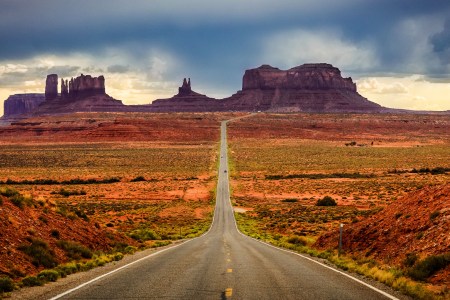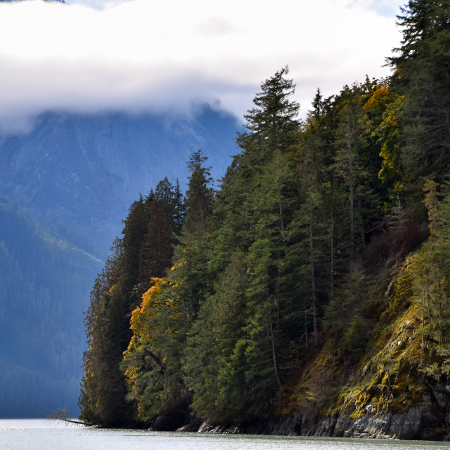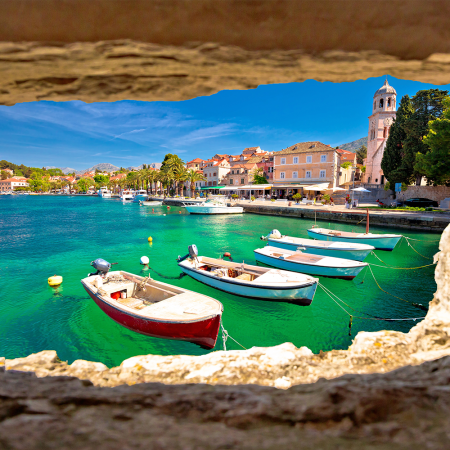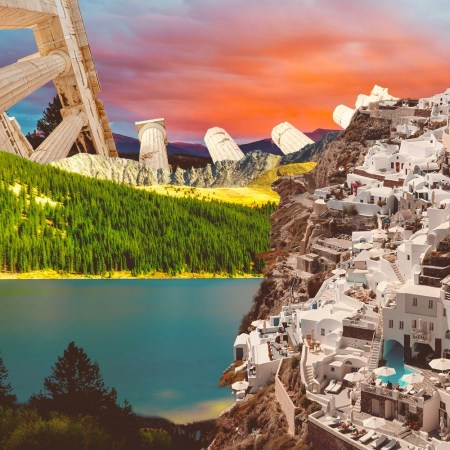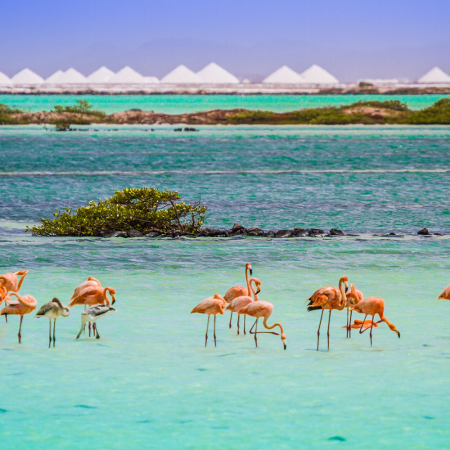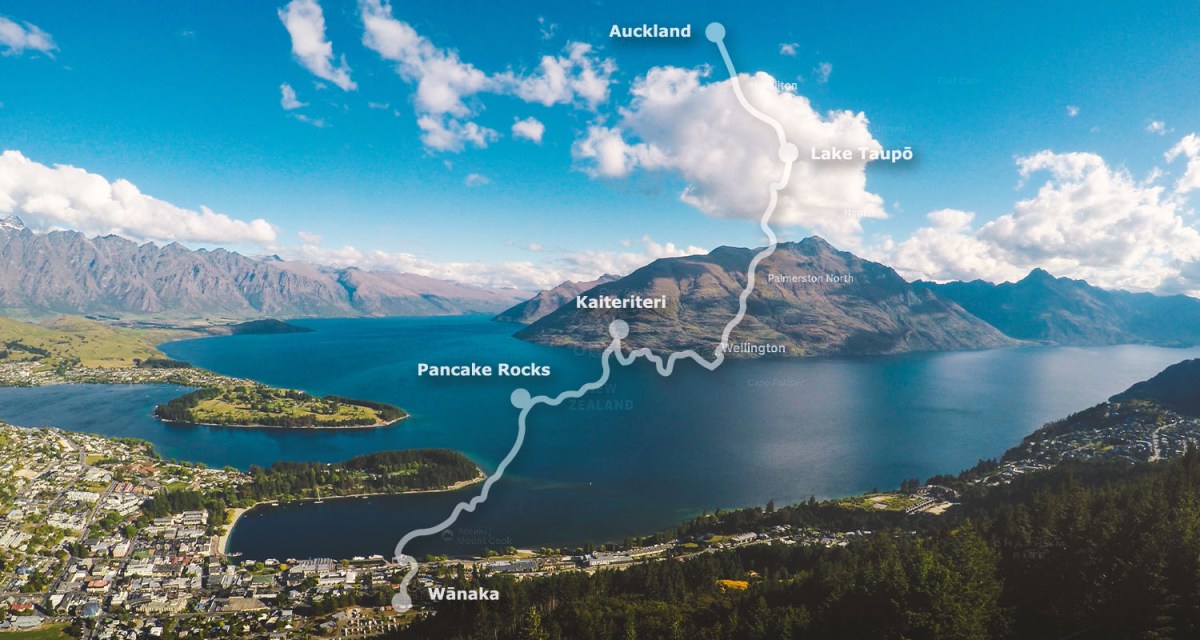
New Zealand was one of those countries that shut down its borders tight during the pandemic, a strategy that turned out to be effective not just for dealing with a highly contagious sickness, but also in making it a coveted destination for travelers once the lockdown was lifted. Even before that, ever since the wildly popular Lord Of The Rings franchise introduced the natural beauty of these two islands to a much larger audience than just travel obsessives and #vanlife connoisseurs, New Zealand has been on the national radar as a bucket list trip for plenty of Americans, 14-hour plus flight be damned.
At the same time, though, as a destination it’s a bit daunting for newcomers — where to start if the country’s natural beauty is the main draw? Is it better to focus on one island at a time? Is one of them unabashedly better? And if not, how do you choose? Besides, by the time you’ve survived a 14-hour flight, doesn’t seeing both seem justified? Luckily, my own personal journey through New Zealand is designed to answer all these questions and more, as I had about a year of preparation before a friend’s wedding on the south island to put together my own plan of attack.
With a little help from a native Kiwi, said friend’s fiance and now-husband (congrats Matt and Theo!), I landed on an approximately 16-day itinerary road trip that led me through most of the major cities on both islands, as well as some more rural stops filled with natural beauty along the way. Feel free to take my blueprint and make it your own, trimming or adding days to suit your own interests and wants, or skipping to one island if you’re not planning to travel to both.
Starting off and (heading back home) from a base in Auckland, I traveled down to Lake Taupō and Wellington on the north island, then took the ferry across to the south island where I ventured over to the golden sands of Kaiteriteri in Tasman, down to the infamous Pancake Rocks in Punakaiki, and finished up with a few days in the lake town, Wānaka, a nearby attraction from the south island’s main port of Queenstown. After a final few days exploring Queenstown, I flew back up to Auckland, crashed in an airport hotel, and headed home the next morning. Here are my tips, tricks, suggestions and recommendations broken up by each city and region.
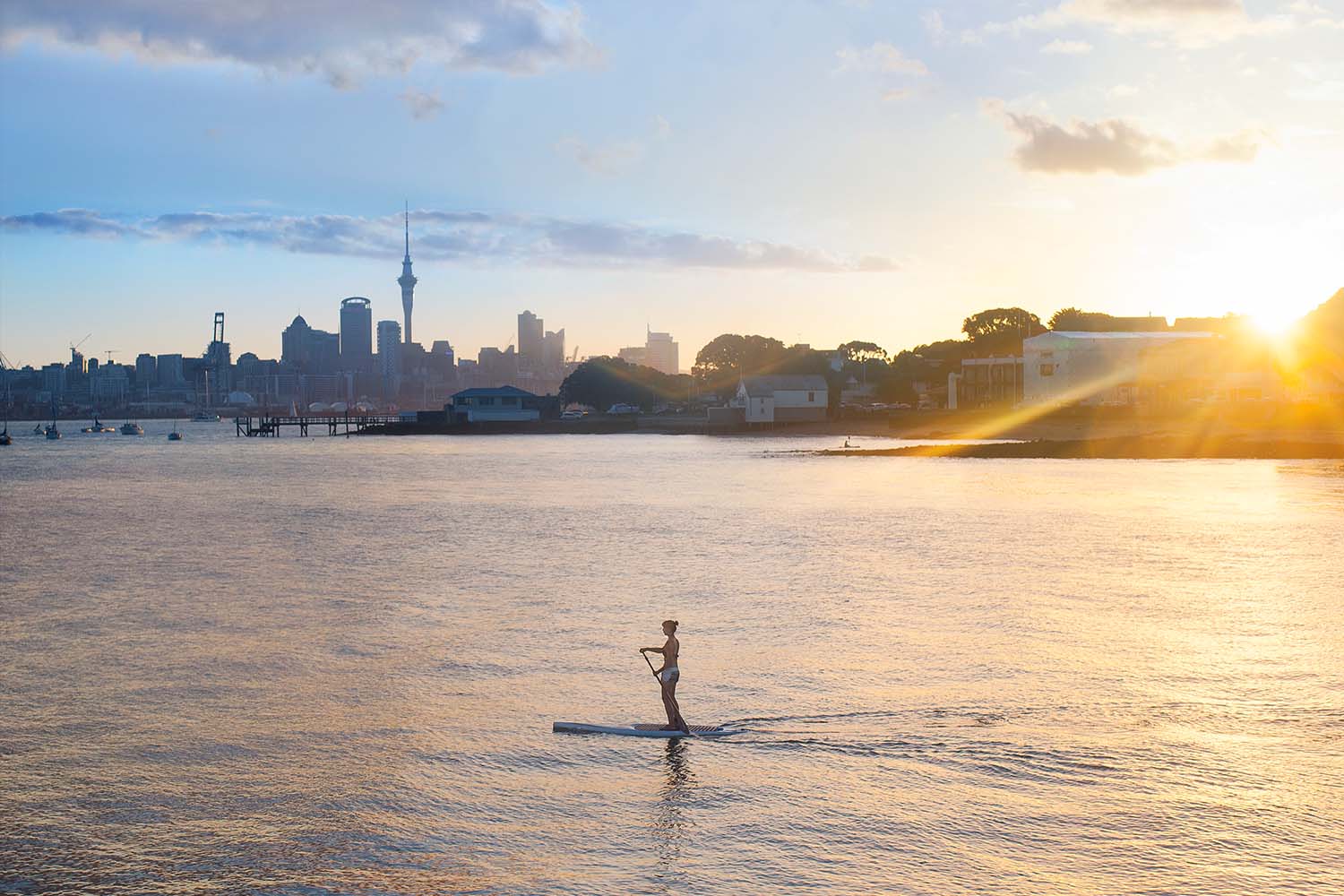
How to get there
The bulk of the direct international flights from America land in Auckland, the largest city in New Zealand by far. You can also fly directly into Wellington, but if you want to see Auckland too, it makes sense to fly there first, and then make your way down to Wellington before heading across to the south island. Another option is flying into Christchurch with a stopover in Australia or another New Zealand city first. (I opted to skip Christchurch for this trip, but it is the second largest city in New Zealand with the largest population on the south island. Unfortunately, several devastating earthquakes in 2010, 2011 and 2016 have deeply impacted the city’s infrastructure, and it’s still in recovery mode from some of the damage. My Kiwi guide recommended skipping it on a first visit in favor of some coastal explorations instead.)
West Coast flights
I have status on American Airlines, so I opted to fly from LA to their hub in Dallas, where they offer a daily direct to Auckland. The perks of going three hours out of the way was the chance to use credit from canceled pandemic-era flight, and a free upgrade to premium economy seats, which matters quite a bit on a 14-hour trip. I booked about seven months in advance of the actual trip, and saw the ticket prices spike just after that, around six months, and continue to go up, so planning ahead is key.
For west coasters looking to depart directly from their home city, Air New Zealand offers direct flights out of both LA and San Francisco, and United also flies direct from SFO to Auckland. Portland and Seattle will have to route through San Francisco or Vancouver to catch a direct. Qantas (operating with Air Tahiti Nui) is another good option to check out, as they offer a one-stop option with a layover in Papeete, and Hawaiian Airlines flies a similar route with a quick stop in Honolulu. Finally, Fiji Airways is another potential one-stop selection, with a brief layover in Nadi, Fiji, before the final leg to Auckland.
East Coast flights
The best bet from the east coast will always be out of New York, and there is a direct from JFK to Auckland happening twice a week on either United or Air New Zealand. Be warned: This flight is over 16 hours. This might be the perfect trip to finally splurge on Business class?
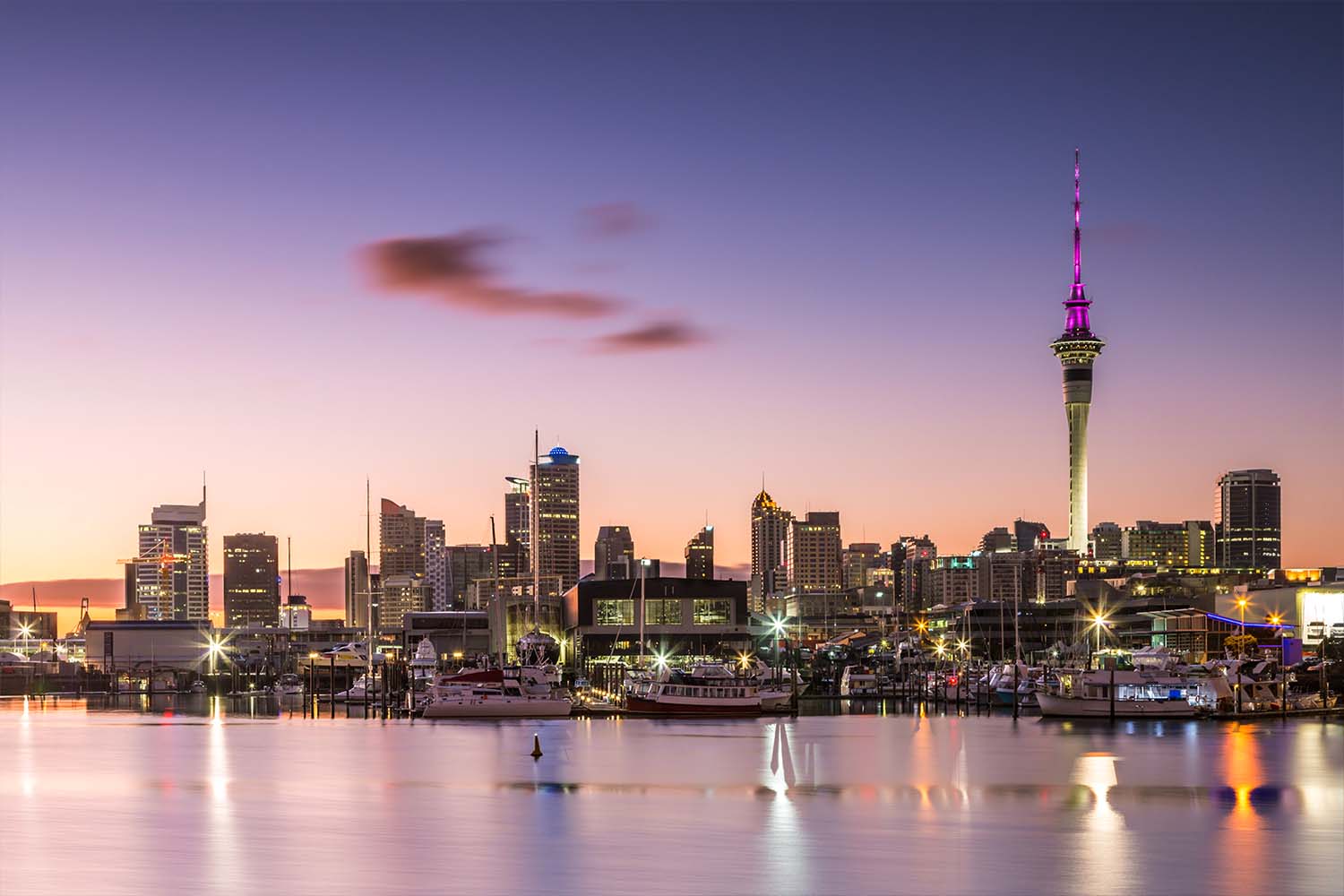
North Island

Auckland: 3-5 days
Think of Auckland as the New York City of New Zealand — though this one is a thriving metropolis with a population hovering around 1.6 million. There’s no other city in the country that even comes close in size, and some might argue, culture, and even though in my experience there was pretty incredible food all over the country, the restaurants in Auckland were particularly exceptional. It is a great town for eating, drinking and shopping, and will likely be the most familiar city for Americans as far as recognizable businesses and brands etc.
Bonus tip: Plenty of merchants in New Zealand don’t take Amex, so bring your other favorite travel points credit card of the Visa or Mastercard persuasion just to be safe.
Double bonus tip: If you pick up a rental car at the Auckland airport, some carriers don’t let you take it across on the ferry to the south island (mine was Hertz). You will be asked to return the first car in Wellington and pick up a new one at the south island ferry terminal. Just make sure to plan for this slight inconvenience ahead of time, disobeying the rule comes with hefty fines.
Optional side trip: If you’re starting your trip in Auckland, consider whether you want to drive up to the rugged, forested Northlands region. As the name suggests, it’s directly north of Auckland. I didn’t, and kind of regretted the fact, but if you do head up there, you’ll have to pre-pay for any toll roads at the rental car counter when you first pick up your car. That means doing some research on what you’d like to see and how to get there — and again, I didn’t make the trek up, so I can’t be of much service here except to warn you about the tolls. If you do choose to go, I’d say a day or two would be the max, as it’s mostly rural cities, colonial towns and wineries that are the draw aside from just driving the coastline, which is always the number one attraction in this country.
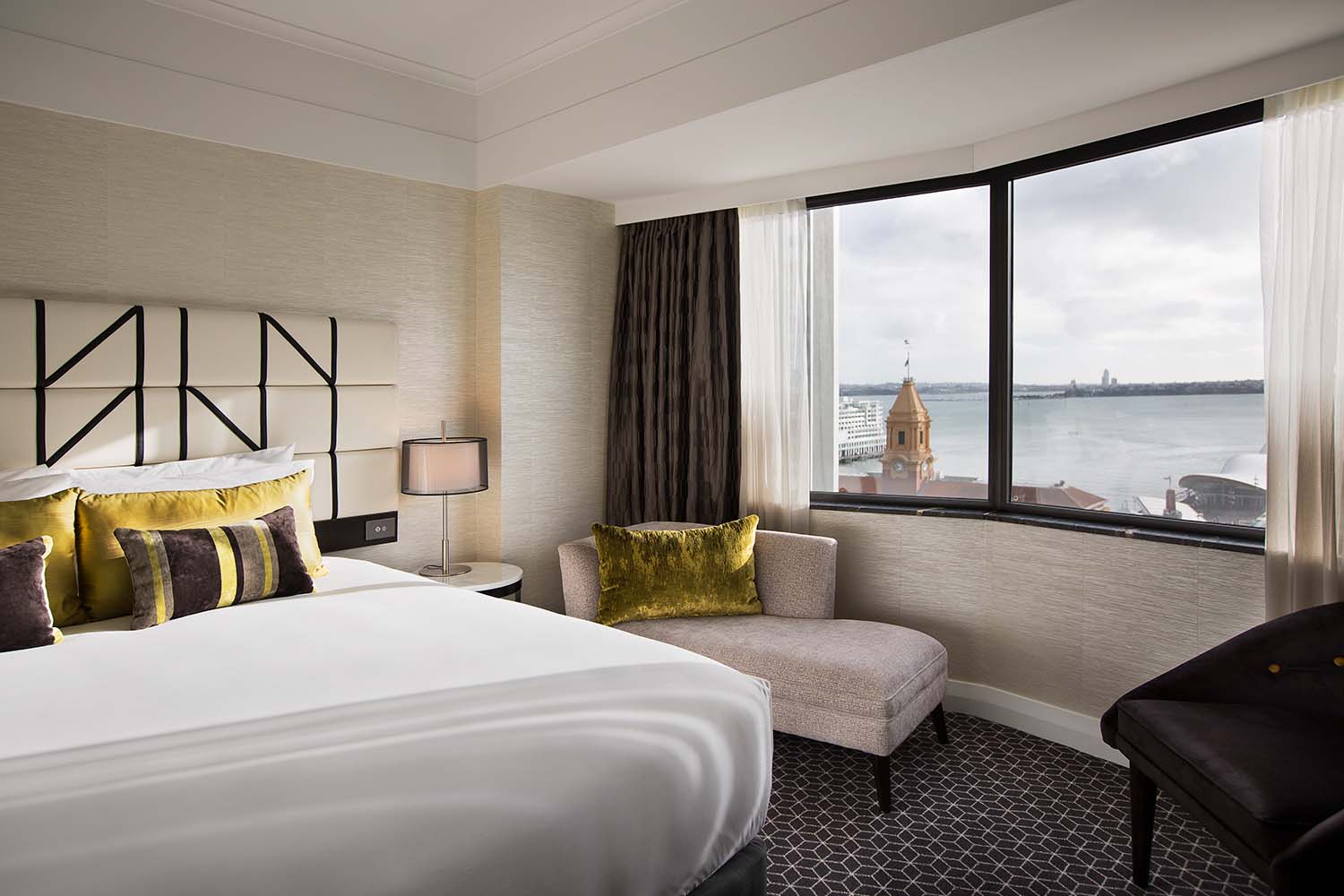

Where to stay in Auckland:
Mövenpick Hotel Auckland
American hotel brands are present in some parts of New Zealand, but other hospitality companies like Accor have a much larger presence. If you’re a points fiend, settling on one hotel company for a trip of this size is a great idea, and I went with mostly Accor properties because they have a presence in all the major cities. Accor is actually the largest hotel operator in the Pacific and has been in the area for over thirty years, so they’re experts in the space. After witnessing that firsthand on a recent trip to Fiji, working with them on this trip was a no–brainer.
If you’re going with Accor, sign up for their membership rewards and use that number everywhere. (Please tell me you’re already doing this for any long trips and extensive hotel bookings!) Mövenpick was originally a Swiss brand that Accor acquired in 2018, and they wasted no time opening the first property in New Zealand with this Auckland hotel in 2022. Since it’s currently their newest property in town, and I’ve never stayed in one, I wanted to check it out.
Located right in the heart of the CBD (Central Business District) on the waterfront, this hotel is perfectly situated within walking distance of countless bars and restaurants, tourist attractions like the Sky Tower, nearby shopping neighborhood of Ponsonby, and the ferry over to Waiheke island. The company’s Swiss origins included holdings in ice cream and chocolate, and instead of a daily happy hour they offer a “chocolate hour” at the restaurant on the top floor of the hotel, with complimentary sweets galore for guests.
Location is everything for this affordable and polished property, with ocean views of the Viaduct Harbor from many of the rooms and the upstairs restaurant, a downstairs coffee bar, in–house valet and walking distance to the Britomart shopping area and the harbor itself.
Hotel Britomart
Another option in the CBD area, this independently owned hotel was actually founded by the brother and sister duo, Suzie and David Lucas, who originally hail from Seattle. Working with a whole host of locals and experts to create a property with an emphasis on sustainability, the hotel initially opened in the tumultuous fall of 2020. Since then it’s been recognized as the first 5-Green Star hotel in New Zealand, as certified by the NZ Green Building Council. You’ll pay around $500 USD a night to snag one of just 99 rooms, but the place is certainly beautiful.
Sofitel Viaduct
If you prefer to be even closer to the harbor, check into the Sofitel Viaduct for luxury accommodations and marina views. Overlooking the Waitemata Harbour, plenty of the Sofitel’s rooms offer balconies and panoramic views of Auckland’s stunning waterfront — and you’re still well within walking distance of all the shops and restaurants in the CBD.
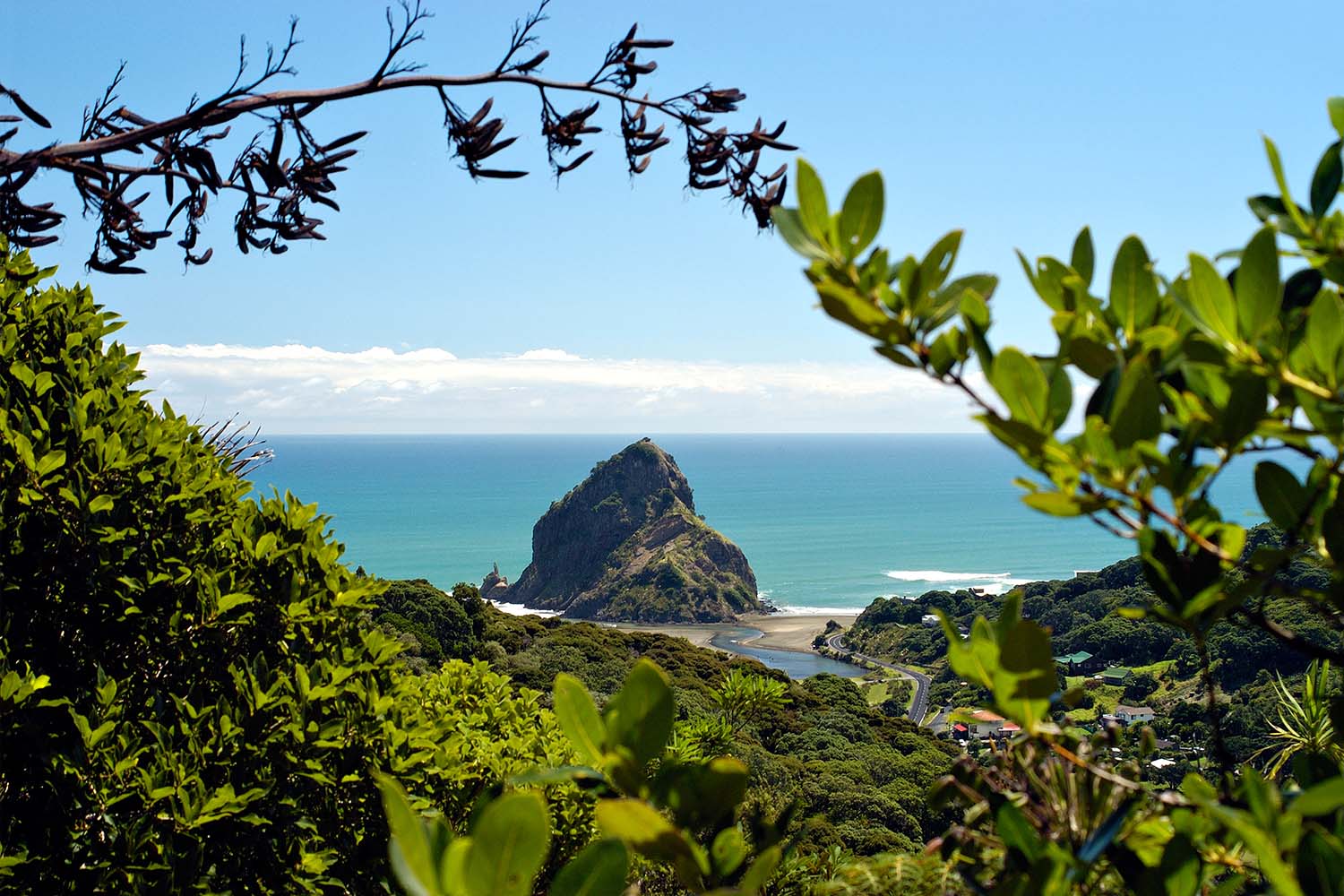

What to do in Auckland:
Visit Piha Black Sand beaches
About an hour or so drive outside the city center, these black sand beaches are some of the most visually stunning in the area. Beloved by surfers due to the massive ways, this somewhat tourist–y spot is still under crowded because of how tucked away it is. Definitely bring along snacks if you head out, as there’s not a ton of options near the beach, probably a good place to bring one of New Zealand’s famous meat pies (more on that below).
Shop and explore Ponsonby
This walkable neighborhood near the CBD is well–known as a shopping haven in the city if you want to pick up trinkets, souvenirs, a new wardrobe or just wander around Ponsonby Road feeling out the vibe. The boutiques are filled with handmade crafts from local artisans and high-end clothing, so there’s plenty to window shop even if you’re not in the mood to buy.
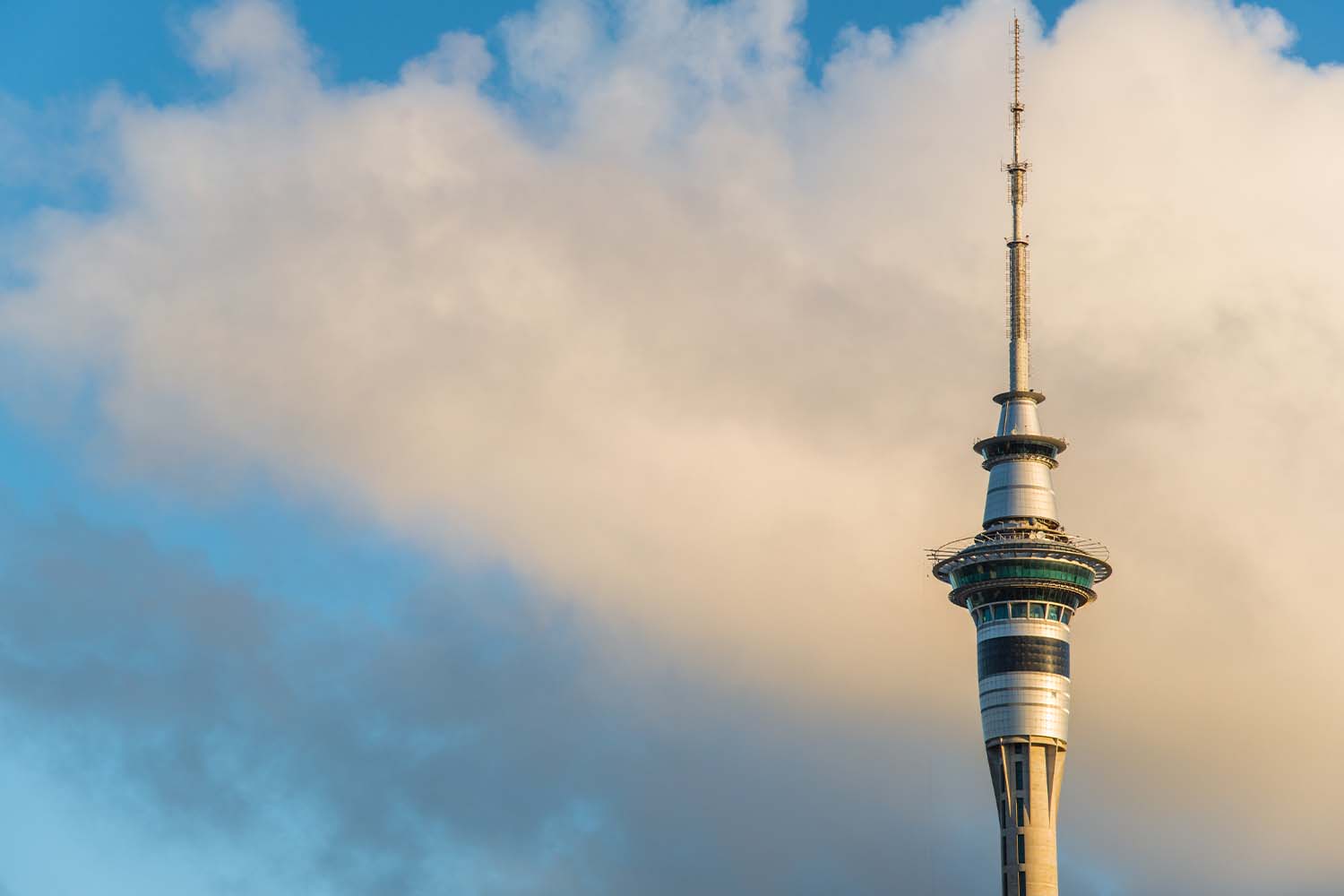
Venture to the top of the Sky Tower
It’s a little touristy, but hey, you’re a tourist! Just like the Hollywood Sign and the Empire State Building, checking out the Sky Tower is a rite of passage for newbies in Auckland. From restaurants at the top of the tower and morning yoga to bungee jumping or walking around the tower’s outdoor edge (in a full harness), there’s plenty of ways to experience the landmark.
Explore Mt. Eden’s volcano walk
Those more inclined to a nature walk than a height–defying tower might have a better time on the short 2-kilometer walk up Mt. Eden. Though it’s very close to the central downtown area, this is the highest volcano in Auckland at a height of about 650 feet. Reaching the summit affords some beautiful views, and the trails are easy to maneuver for most — plus there’s plenty of parking if you want to drive right in.
Take the ferry across to visit Waiheke island
Hands down my favorite day trip from Auckland was visiting the winery-laden isle of Waiheke. If you’re familiar with the LA to Catalina trip, this is in that vein, and the island is similarly a vacation home haven for plenty of locals. Save yourself taxi fare and climb the meandering hill from the ferry dock, then reward yourself with Island Gelato and a bevy of fresh seafood at The Oyster Inn. You can also book an overnight stay on Waiheke, and yes, the Oyster Inn itself does host guests. Staying there or a romantic night at Mudbrick Vineyard would be my suggestions.

Where to eat in Auckland:
Amano
I liked it here so much that I came twice during — and during a three day trip! They just have everything you want…housemade pastas laden with fresh seafood, bougie cocktail and mocktail options, a studied wine list, fresh breads and salads, pate, steak, lamb shoulder — it’s all here, nestled into the exposed brick and wooden beams. They open in the morning and even have breakfast cocktails, takeaway options, and, of course, fresh made pastries and coffee. If you’re within walking distance, you won’t go just once.
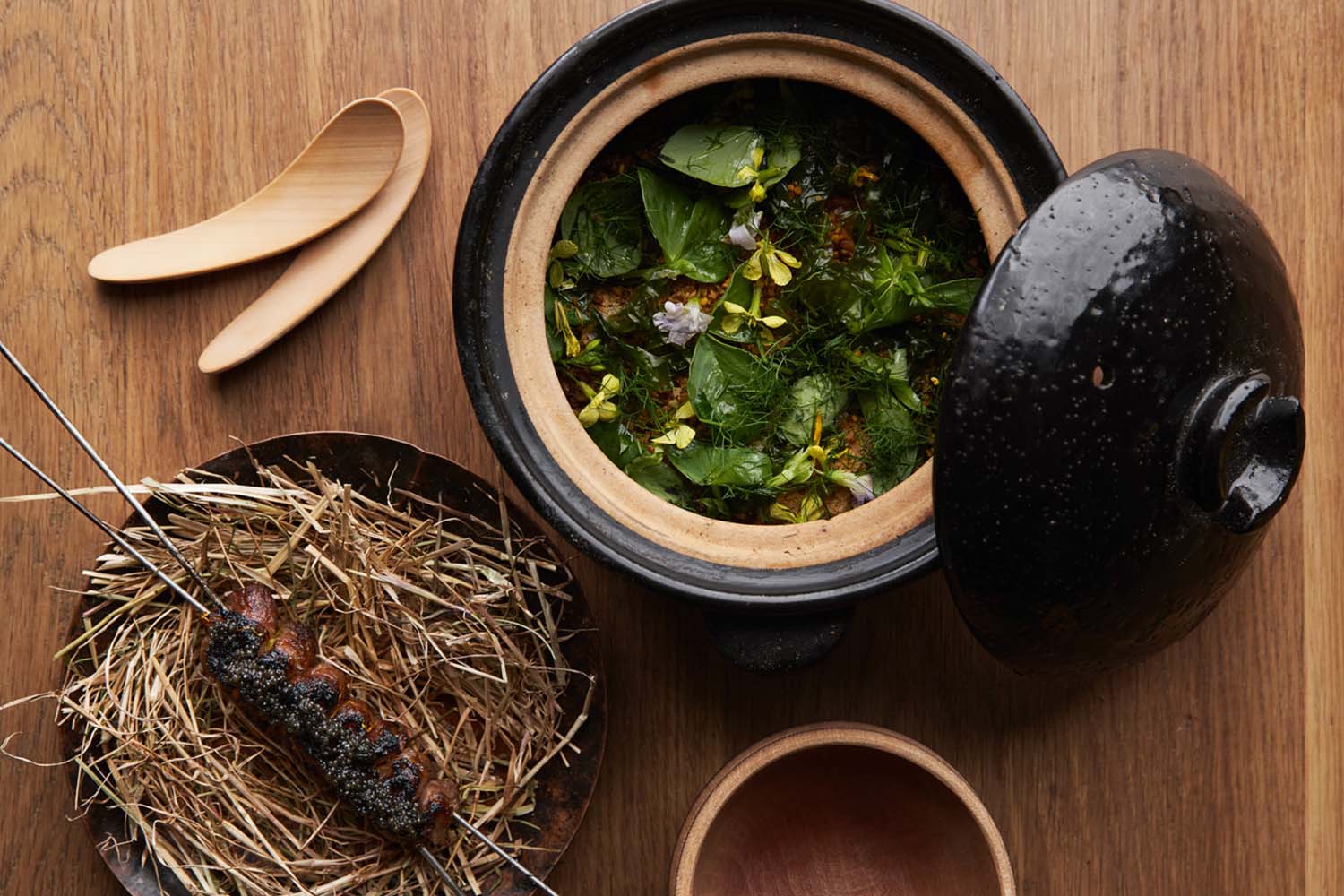
Pasture/Boxer/Alpha
Fine dining lovers have likely already heard about the seven-seat prix fixe menu at Pasture from chef Ed Verner, something of a local legend at this point. A restaurant without tables and no dietary accommodations might sound unfeasible, but Verner’s mesmerizing dishes bring new ingredients to the table and transform old ones. For a slightly less intense (or pricey) experience, the crew have also opened Boxer, the de facto bar for Pasture, and Alpha, a test kitchen, bakery, and an a la carte joint at the front of the space that’s deliberately more affordable and accessible. Knowing my trip was over two weeks, I went there, and have been thinking about the caviar grilled cheese with honey “snack” ever since.
Cazador Deli
Given the amount of driving and walking you’re likely to do on a trip of this nature, keeping a variety of snacks on hand is a good move. As I mentioned earlier, in New Zealand, pie has a whole new meaning, one that has nothing to do with dessert. Plenty of bakeries, shops and even gas stations sell hand–held size savory pies stuffed with cheese, meat, gravy and vegetables that make for an excellent lunch, midday snack or midnight tune up. I tried almost every kind that BP gas stations sell (they take Amex) as well as a few other bakeries around town, but by far the ones at Cazador Deli blew everyone else out of the water. This deli is fairly near Mt. Eden, so if you do venture out for that walk, stop by here and stock up on pie, too.
Bonus tip: Even in the heart of the CBD on a weekend, restaurants close early in New Zealand. Make sure you’re out and about between 7-8 PM latest to snag a table or a bar snack before kitchens close.


Lake Taupō: 1-2 days maximum
I’m originally from Oregon, so I grew up thinking Crater Lake was the pinnacle of natural beauty in the world (still kind of think that, to be honest). If you’re similarly awed by crater lakes, you’ll love Lake Taupō, which is the largest freshwater lake in New Zealand (!) Definitely a local’s destination, this massive lake was formed after an eruption from Taupō Volcano left a hollow known as a caldera, which was then filled with water. Right in the middle of the north island, this is a perfect stopping point on a drive from Auckland to Wellington, which is a straight shot of eight hours. Technically, you could do it in one day, but why not do as the locals do and check out a pristine lake on the way?

Where to stay in Taupō:
I found out about this lakeside paradise too late to do an overnight, so I had to be satisfied with a day trip, but if I were going to stay I’d probably go for a night at Lake Taupo Lodge. Inspired by Frank Lloyd Wright, the couple who built and own this luxury lodge also live out there on their own little plot of land… I’m guessing a night here is worth any price but there are countless options at all price points available.

What to do in Taupō:
New Zealand is well known as one of the adventure sport capitals of the world, and Taupō is a great place to get into some of them. From skydiving to boat cruises, hikes through volcanic alpine terrain, visiting geothermal pools or dramatic waterfalls, to river rafting, there’s plenty to do on and around the lake. Still, the number one activity is probably fishing, so expect to see a lot of veterans out on the waters.
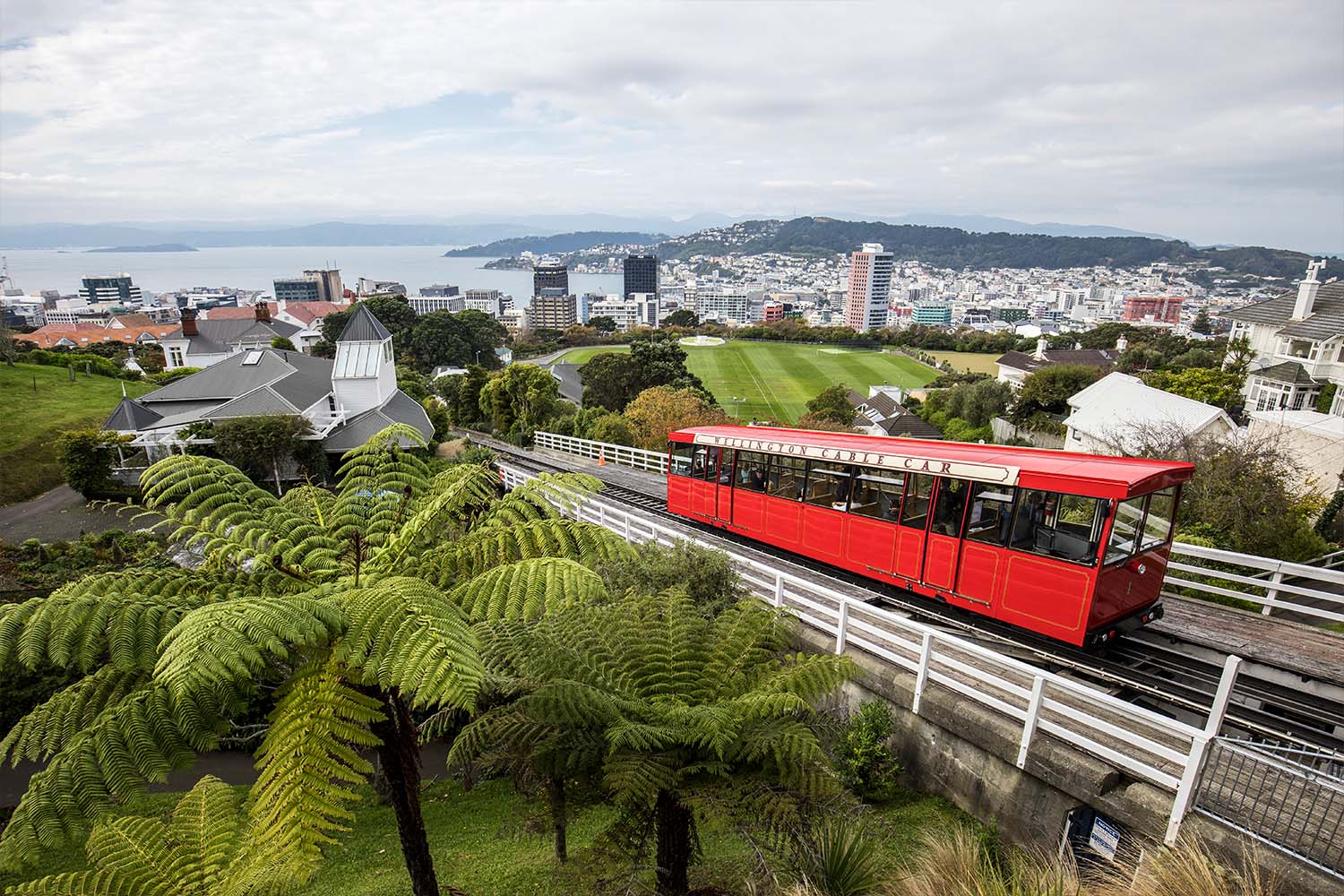

Wellington: 2 days
Remember, every city after Auckland will be markedly smaller, even when you’re not in a rural lake town. The bulk of Wellington is located right on the water, but steep cliffs make up the other half of the city, kind of like a San Francisco vibe. It’s a city of close to 200,000 people, and there is a pretty robust film industry connection with many productions filming here, in part to the presence of local artisans who run Weta Workshop, another company made famous by their work on Lord Of The Rings. It’s also the unofficial coffee capital of the country, and pretty much any local shop you go into will have great brew.
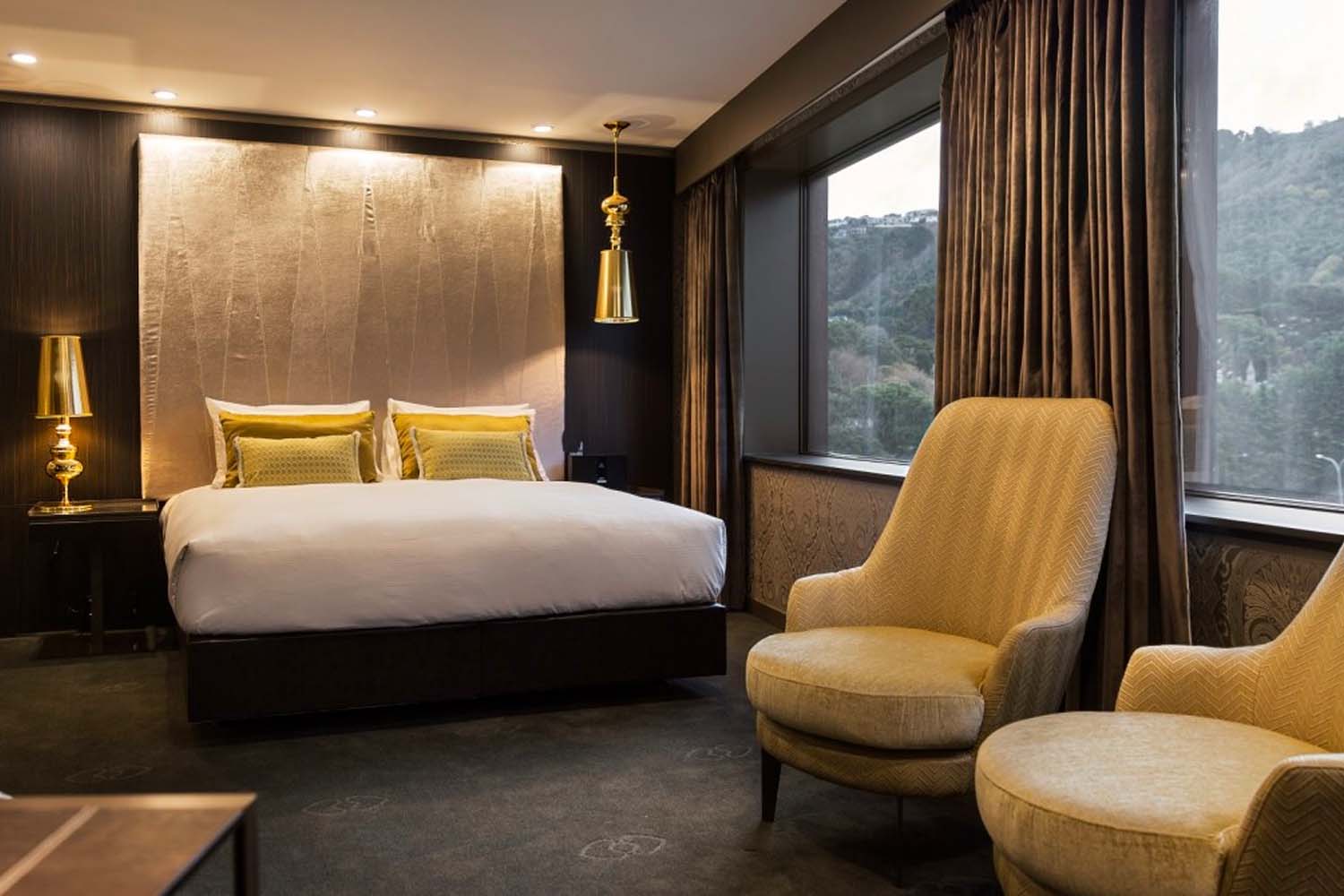

Where to stay in Wellington:
Sofitel Wellington
The options are more limited in Wellington, so sticking with a Sofitel is the wise choice — especially since this property comes with a fine dining steakhouse in the lobby, the Jardin Grill. New Zealand produces some of the best beef in the world, and this is the perfect place to try it.

What to do in Wellington:
Take the Weta Workshop tour
These masterful creatives are responsible for some of the most iconic costumes, props and vehicles in the world. Originally started by just two founders, Richard Taylor and Tania Rodger, the team has now grown exponentially, including an additional outpost in Auckland. At just $50 NZ for a 90 minute tour, this lowkey walking experience is well worth the price, even if you’re not a diehard cinema fan.
Hike or drive to the top of Mount Victoria for epic views
Since most of the big New Zealand cities are port cities, the potential for excellent views is always high. Right in the center of Wellington, the viewpoint from Mount Victoria is one of the best places to go to get a sense of this city’s sprawl, and the surrounding ocean. On a clear day, you can even get a peek at south island miraging in the distance if you know where to look.
Ride the Wellington cable car
Again, is it a little touristy? Yes. But tickets are only $9 NZ and the trip up the hill takes less than ten minutes. At the top, take in the views, peruse the museum and botanical gardens, or get a snack and a beer at the appropriately named Cable Top Eatery. As is often the case with trams, it’s about the journey, not the destination.
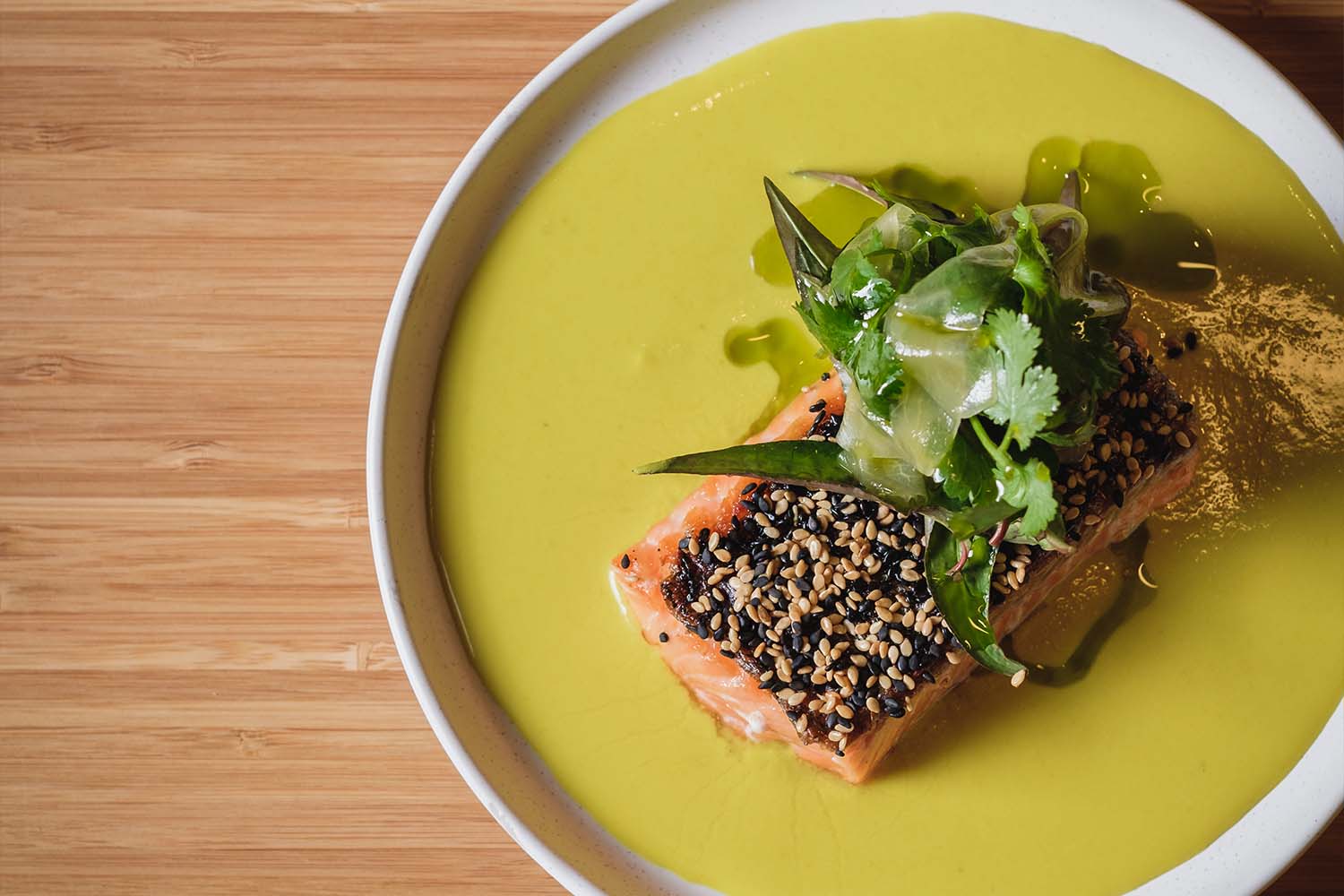

Where to eat in Wellington:
Koji
I know I ate at other places in Wellington, but the single most impactful experience of this city for me was eating at Koji. Owners Johnon MacDonald and Kat Strand regularly tour New Zealand in order to source specific local ingredients they want to use in the restaurant’s pan-Asian cuisine, which incorporates traditional Kiwi flavors right alongside influences from Malaysia, Japan, Thailand and more. Don’t waste any time, settle in for the “just feed me” chef’s menu, a relatively affordable prix fix of nine dishes for $85 NZ — which leaves plenty of room in your budget for wine pairings. Also, you will very likely need a reservation, so save yourself the trouble and make one before your trip.
The Hangar
Great little coffee shop with a lunch-y/brunch-y all day menu and a delightful array of cold coffee options, plus other ideas like Bloody Marys, an assortment of wines and even an espresso martini!
Best Ugly Bagels
These are the foremost New Zealand bagels, done in the Montreal style because the owner, Kiwi chef Al Brown, had one in Canada and fell in love with it. Similar to their Canuck counterparts, these bagels are hand rolled, poached in honey water, then wood fired in a stone oven, this one burning the very New Zealand timber, Manuka wood. If you want to go even more local, you can get one smeared with marmite (the New Zealand vegemite) and butter — but they’re just as great with standard cream cheese or done up as one of the specialty sandwiches. They’re a great option for a quick local snack in Wellington — including a kiosk at the Wellington airport.
The 20 Best Scenic Drives in America
A panel of drivers, enthusiasts and collectors chart the country’s most iconic road trips, from the PCH to the Tail of the Dragon
The Ferry
It’s not difficult to find the ferry ports in Wellington, as they’re within a five minute drive of each other and centrally located downtown. Remember to leave enough time to drop off your rental car and make your way back to the harbor. There are two ferry companies, Interislander, the larger, more tourist-friendly original operator, and Bluebridge, the smaller ferry geared more toward locals. I originally pre-booked on Bluebridge and had a really bad experience, only to be saved by a day-of ticket on the Interislander, so that’s definitely my recommendation between the two.
The whole trip from Wellington to Picton, the small ferry hub town on south island, takes about three and a half hours, as the boat goes pretty slowly the whole time navigating the narrow strait between islands. If you don’t get seasick, the views are stellar, but don’t be surprised if the lull of the boat rocks you to sleep.
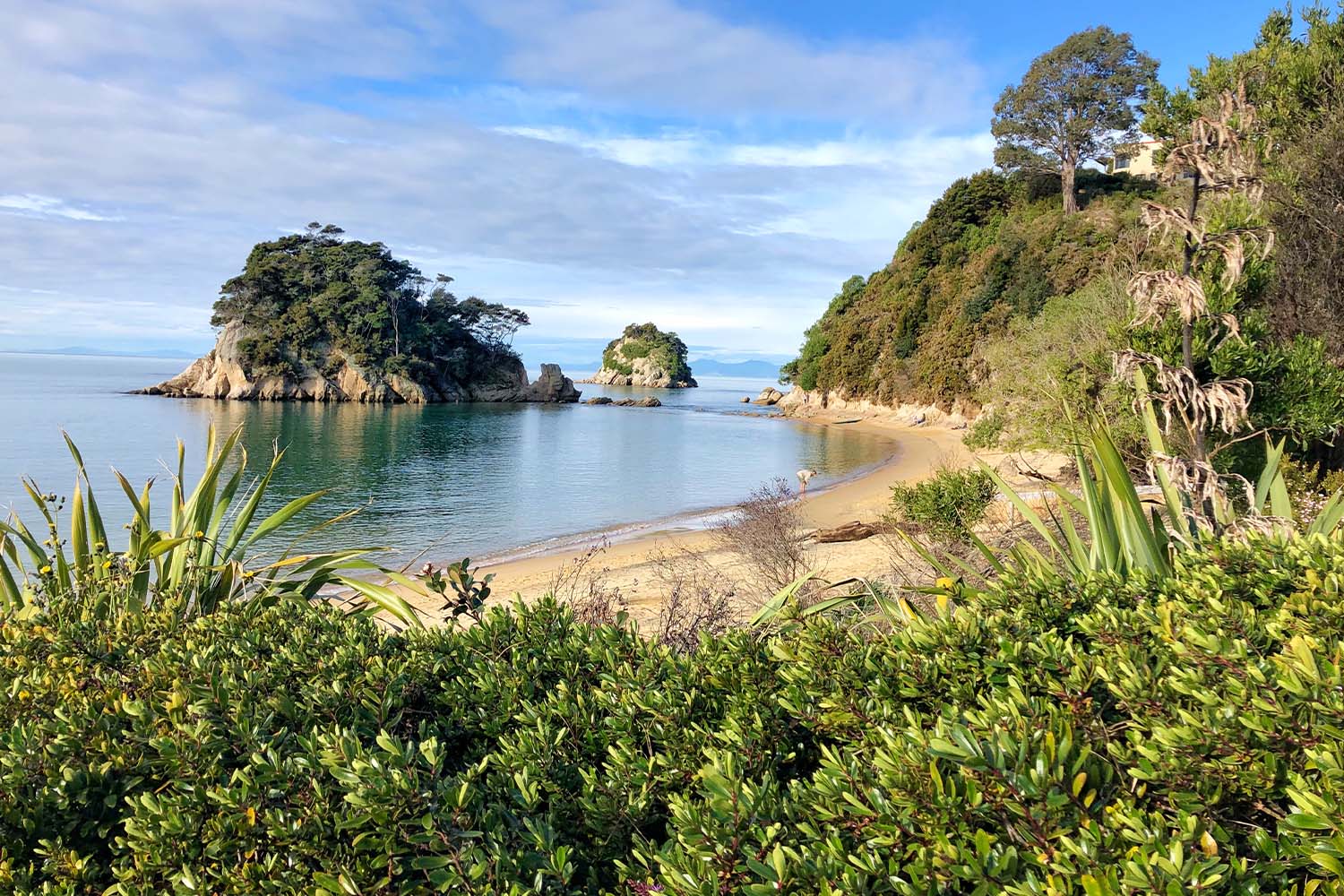
South Island

Kaiteriteri: 1-2 days
Picton is by no means a destination unto itself, so roadtrippers can either head four and a half hours south to Christchurch, or crawl along the south island’s northwest coast for some pretty incredible beaches. I opted for the latter and drove about three hours to Kaiteriteri, a seaside resort town in the Tasman region that’s near the Abel Tasman National Park. Known for its golden, almost egg yolk-yellow sands, and shockingly blue water. The sand looks magical, but it’s really just the result of crystals, mica and quartz weathering off ancient granite over the course of the years.

Where to stay in Kaiteriteri:
Kimi Ora Eco Resort
Full disclosure I found this place on Hotels.com, but it turned out to be one of the unexpected gems of the whole trip. With ocean views from plenty of the suites and the property’s main restaurant, charming exposed wood and cozy cabin touches in the room, and a whole suite of hot and cold pools including a steam room and two saunas, this hotel is like a hidden paradise. Very crunchy, with a vegetarian restaurant and a true emphasis on sustainability, there’s even a glow worm trail built into the hill above the hotel, so guests can go explore this fascinating natural phenomenon.

What to do in Kaiteriteri:
Aside from luxuriating in the spa pools after hours of driving, there are tons of ocean activities available too, like kayaking and cruises, or a nearby mountain biking trail that’s also quite popular.

Where to eat in Kaiteriteri:
There isn’t a whole lot of culinary game in town, but Kimi Ora’s on-site restaurant, The Views, served delicious vegetarian pizza and salads, as well as dishes made with tempeh, cauliflower, tofu and other meatless options. A full breakfast buffet was loaded with treats like homemade chia pudding, as well as eggs and cheese, toast, pastries and more.
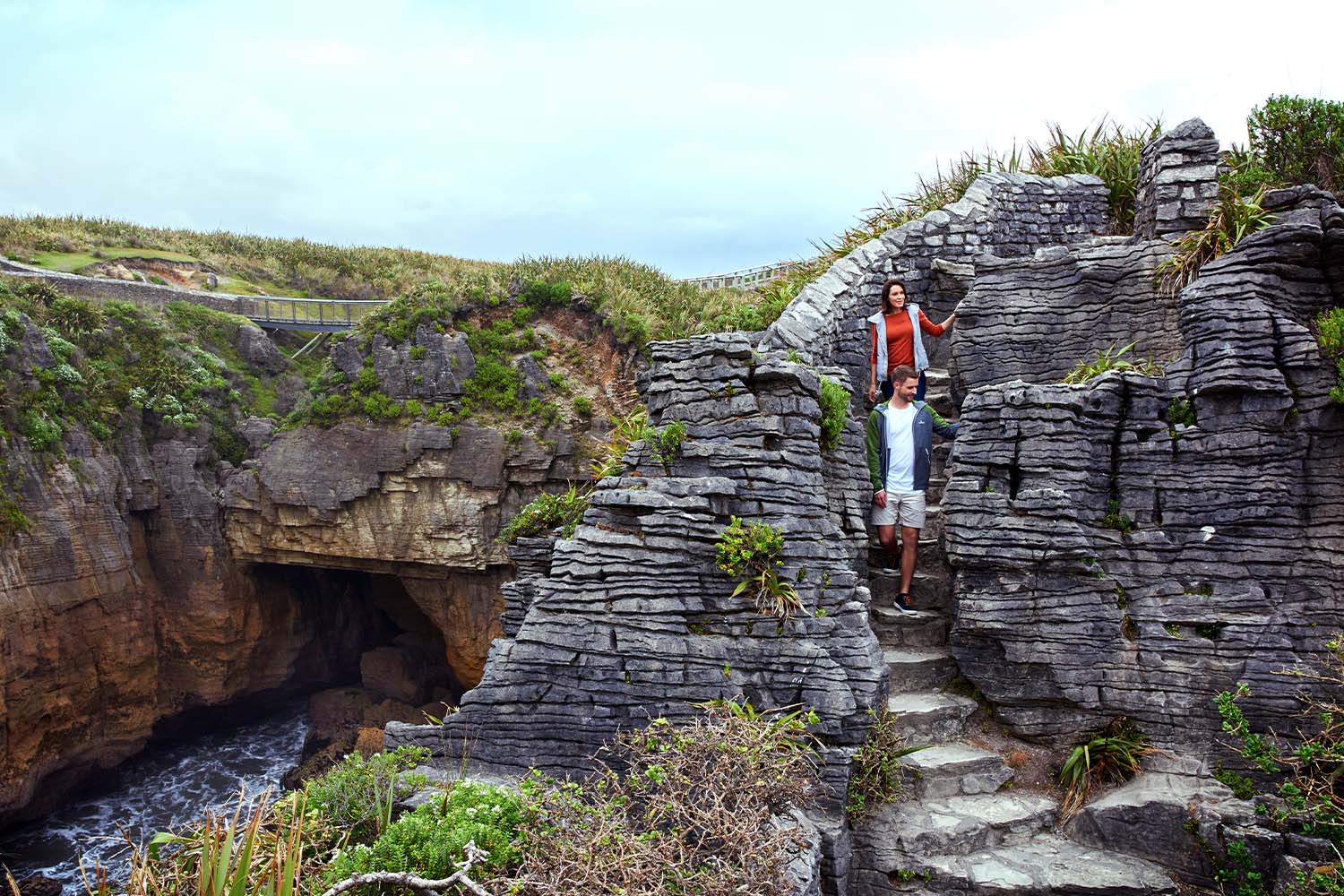

Punakaiki: 1 day
Some of the most beautiful coastline on the entire southern island is the area leading up to and around the tiny village of Punakaiki and the Pancake Rocks and Blowholes landmarks. It’s about four hours driving between the northwest area of Kaiteriteri down to Punakaiki, so as long as you leave in the morning you’ll have the bulk of the afternoon to go on the short hike around the Pancake rocks, maybe dip in the ocean, take lots of photos and fall asleep to the sound of the crashing waves.

Where to stay in Punakaiki:
As this is a fairly rural place, even the nicer accommodations tend to be dorm and motel-like. Hostels abound and are the more popular choice by far, but if you aren’t up for bunk beds and shared showers, look into The Ocean View Retreat – Punakaiki, one of the only properties around with AC and wifi.

What to do in Punakaiki:
The beach is the thing, whether you’re on the short, paved walk through the Pancake Rocks reading about their history, sitting on the sand listening to the waves crash, driving along the coast to take it all in, or tucked into your hotel room watching the sun come down. This isn’t a place with activities — the place is the activity.

Where to eat in Punakaiki:
If you’re staying at The Ocean View Retreat, they have a restaurant on-site. Across from the Pancake Rocks entrance is the rather touristy Pancake Rocks Cafe that serves, you guessed it, pancakes, among other things. Further up the road is the Punakaiki Rocks Hotel & Garden Bar, serving up pub and diner fare and plenty of libations from 8 AM until 9 PM, seven days a week.
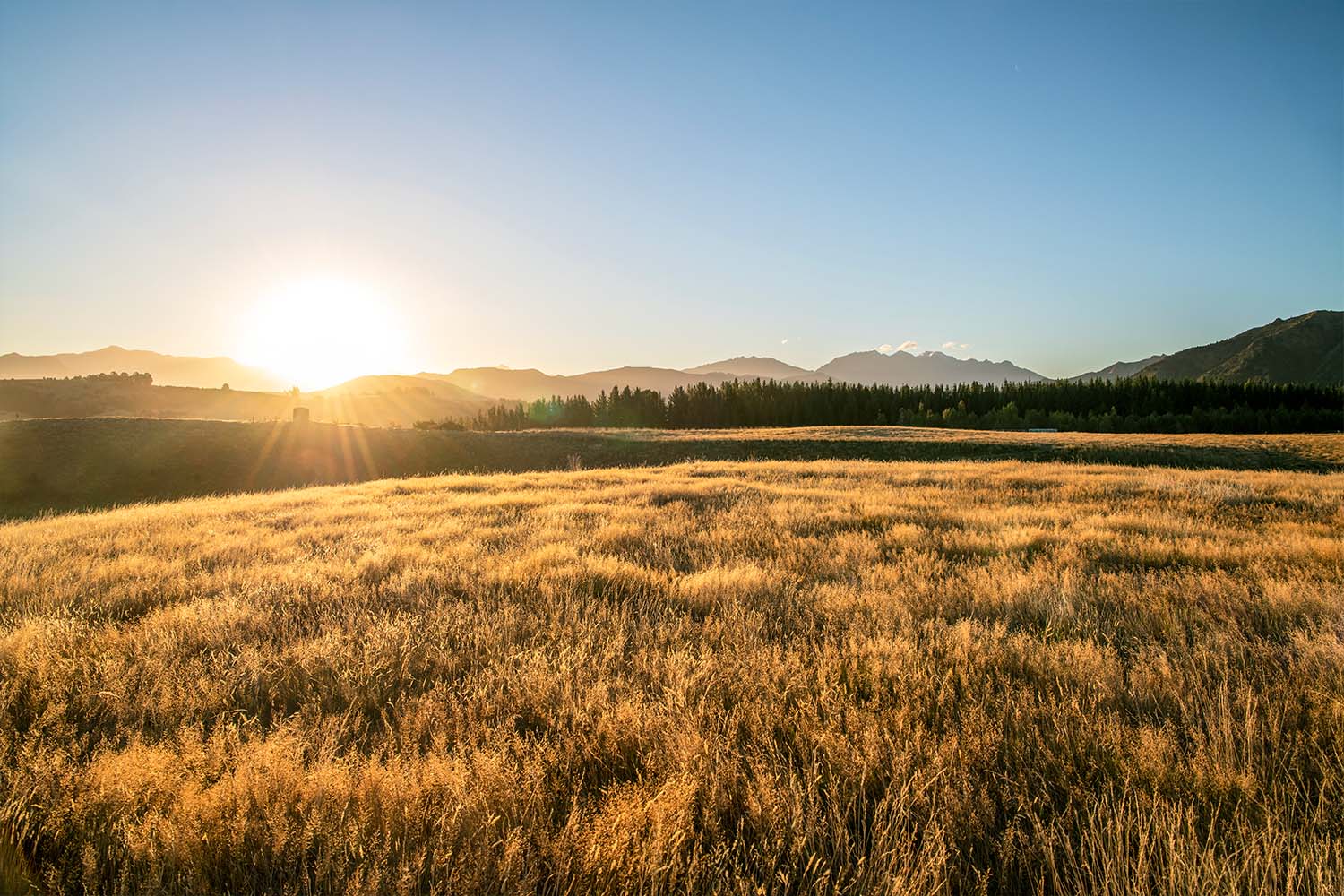

Wānaka: 3-4 days
The drive from Punakaiki to Wānaka will be the most brutal of the trip, coming in around six and a half hours. That goes up to just under eight hours if you opt to go the mountain way in order to take in the majestic views at Arthur’s Pass National Park, as anyone who has seen it will urge you to do. Settle in for a car day and stock up on coffee, snacks and meat pies at gas stations along the way. The good news is, once you hit Wānaka, the next and last location is only an hour or so away, so this is the last long car day.
As for Wānaka itself, this is one of the most popular resort towns in all of New Zealand for a reason. Aside from being beloved by snow bunnies in the winter, it’s a gorgeous place to summer due to the proximity of the lake, which easily earns its constant comparison to the Swiss alps.
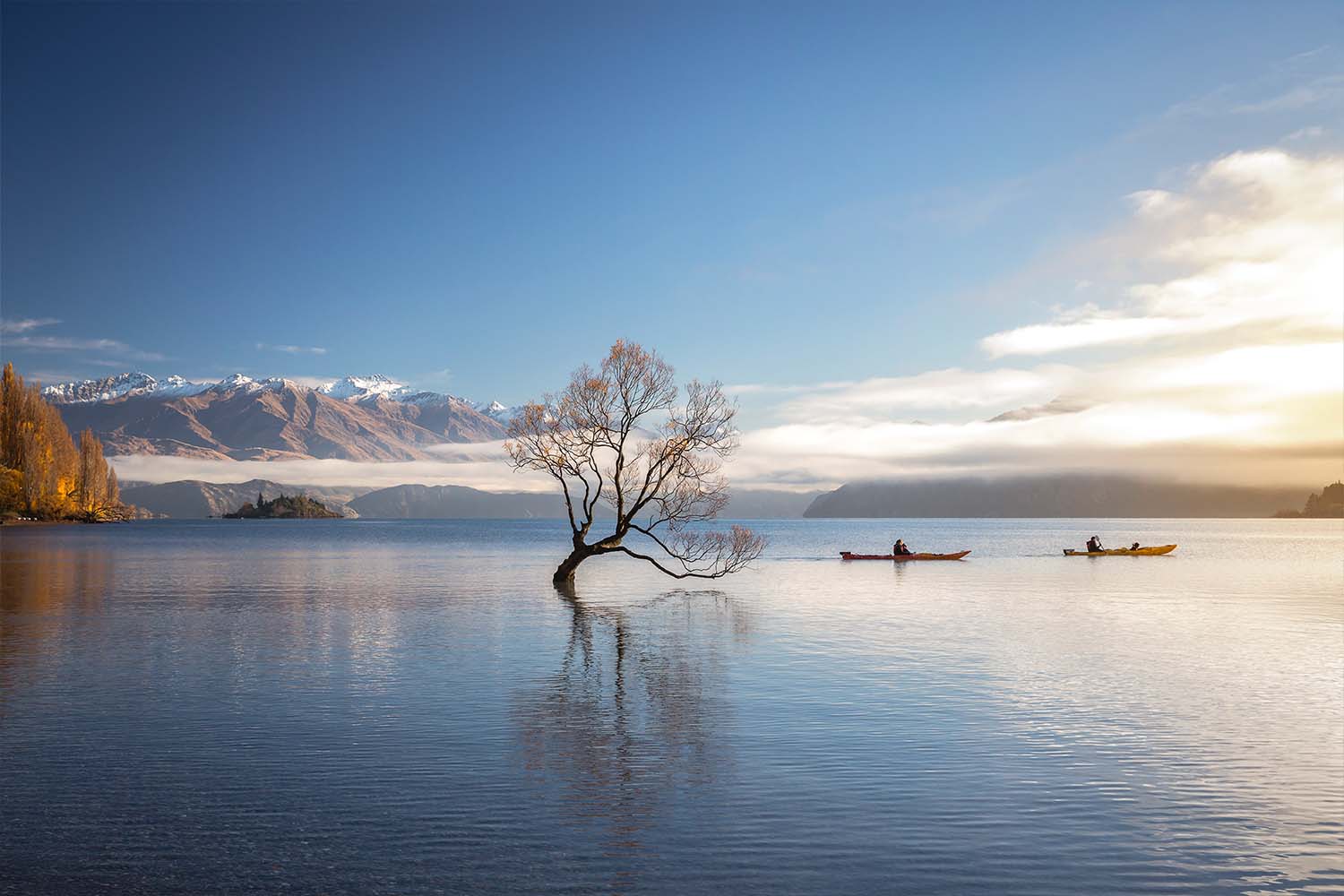

Where to stay in Wānaka:
Edgewater
I can’t say enough good things about this resort, especially since it offers private beach and lake access that was literally 2-3 minutes from my room’s patio door. As the only resort in town actually perched on the lakeside, it has a distinct advantage over other accommodations, and a central restaurant, the Wineglass Cafe, is another draw, not just for Edgewater guests but all of Wānaka. If you think you might like to stay here, consider booking your room right now! This place sells out all the time, and it was only through repeated emails and cajoling, and eventually a manager taking pity on me and upgrading my room, that I was able to spend four solid nights here.
After the upgrade, I was in a lakeview apartment that could’ve easily slept four people when you include the queen size sofa bed in the living room. With a separate bedroom, desk area, kitchenette and a luxurious spa bathroom, I’d say this was one of my favorite experiences in New Zealand and I can’t recommend it enough.

What to do in Wānaka:
Day Trip to the Blue Pools
Just an hour or so outside of Wānaka, and after a lovely drive alongside two lakes, no less, these glacial pools are located about a 20-25 minute walk from a central parking area. Taking the trail down to the pools requires crossing over a couple of rope bridges, so keep that in mind as far as mobility. Once you’re there, though, these breathtaking (literally, they’re freezing) crystal clear pools are more than worth the trip.
Wine tasting and at Rippon Vineyard
These days, New Zealand and Australia have confidently entered the ring as interesting winemaking regions in their own right. Still, Rippon is something special. Just outside the main borders of Wānaka, and only a few streets over from Edgewater, this family-owned vineyard and tasting room is perched on a hillside overlooking the lake. They specialize in biodynamic wines and stunning postcard–ready views, with appointments for tastings are available 12-5 PM, seven days a week. Just keep in mind there’s no restaurant or food options on site, so a pre–tasting lunch at the Wineglass Cafe might be the move.
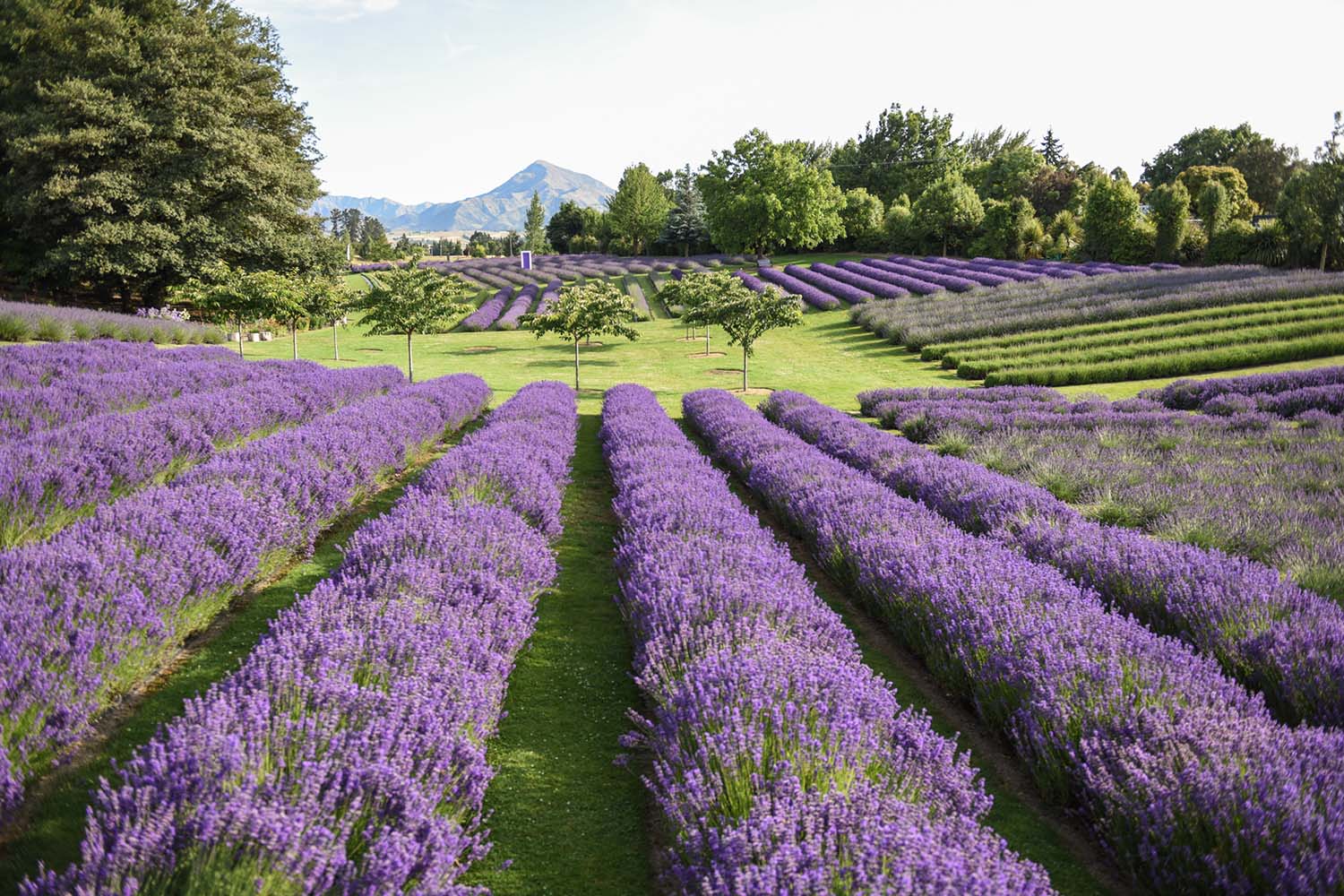
Wander through the Wānaka Lavender Farm
Like something out of a movie, the bucolic fields of lavender that guests can explore for an entrance fee of $7-15 NZ are worth every penny. Across twenty acres of gardens, including the occasional barnyard animal here and there, the Lavender farm is a stunning testimony to the healing power of plants. Honey from the bees who pollinate the fields is available for purchase, as are any number of botanical and herbal concoctions made from and with the flowers. Great gift ideas: lavender water spray, lavender lip balm, lavender bar soap.

Where to eat in Wānaka:
There is a sweet little food truck lot on Brownston Street with a bevy of options for takeaway, and since plenty of rooms in town come with kitchenettes, stopping by the New World Supermarket for some groceries is another idea. Big Fig Wānaka offers a cafe style “slow food” approach that’s deli-like, and Adam & Eves bakery can fill in whatever blanks there might be for bread, pastries, coffee and snacks.

Queenstown: 3-4 days
Since Wānaka is the idyllic small town feel on south island, Queenstown manages to feel big by comparison — except it isn’t. Wānaka clocks in with a population of just under 9,000, Queenstown has just over 47,000. Both townships are located on lakes, but with a lot more infrastructure, like an airport, highways, and local industry, Queenstown manages to feel like a city while Wānaka is decidedly a village. That’s good news if the last week or so of small, rural enclaves on the south island have left you wanting a little bit of bustle and excitement.
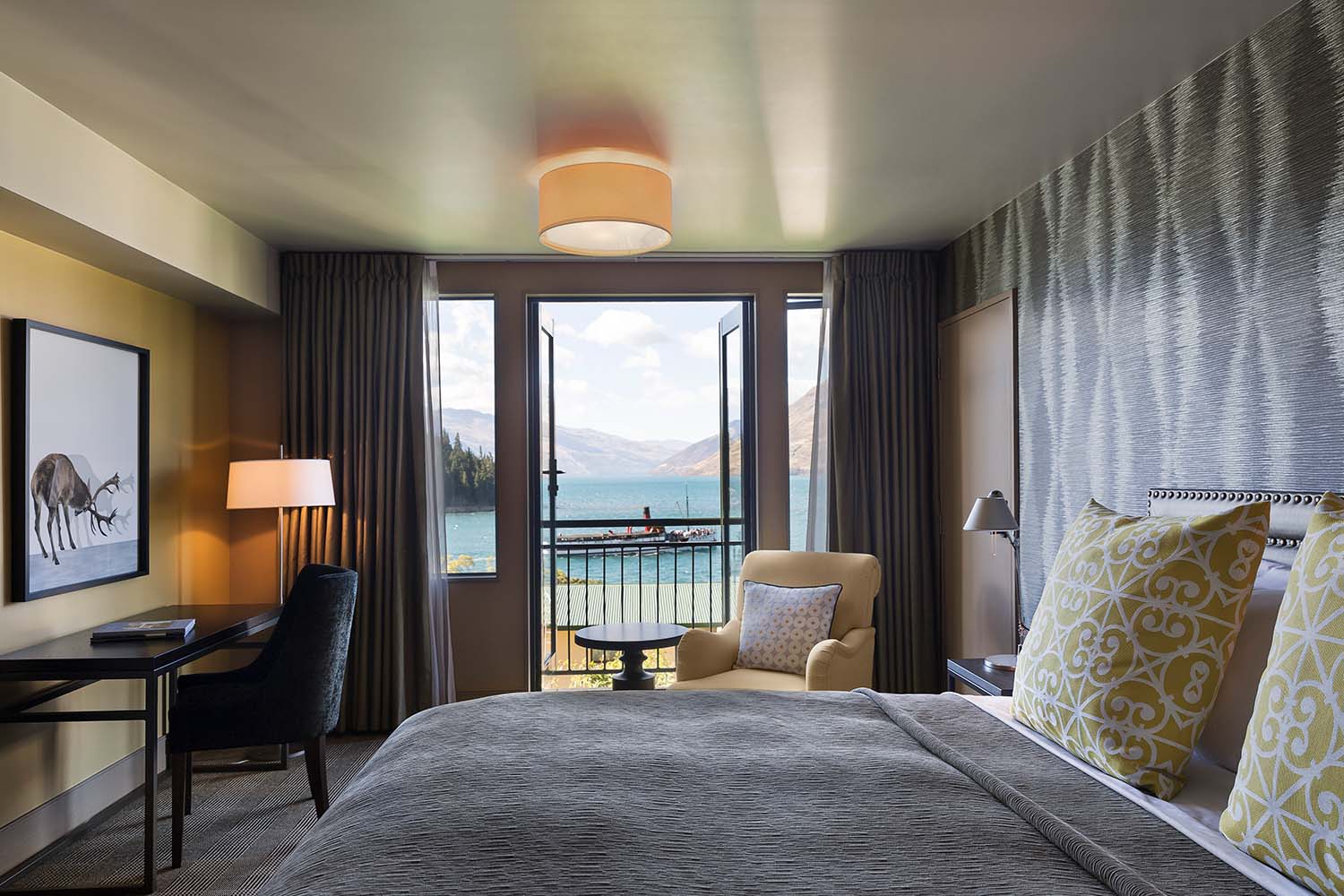

Where to stay in Queenstown:
St. Moritz
Another Accor brand, this hotel might not be quite as bougie as its Swiss counterpart, but what it lacks in Olympic status it makes up for in charm. Queenstown is another ski bum haven, so summer is the low season, which makes for a quiet and serene hotel atmosphere. As most of the common rooms and plenty of hotel suites overlook the lake, guests would naturally wander toward the windows to take in the natural beauty, like flies to honey.
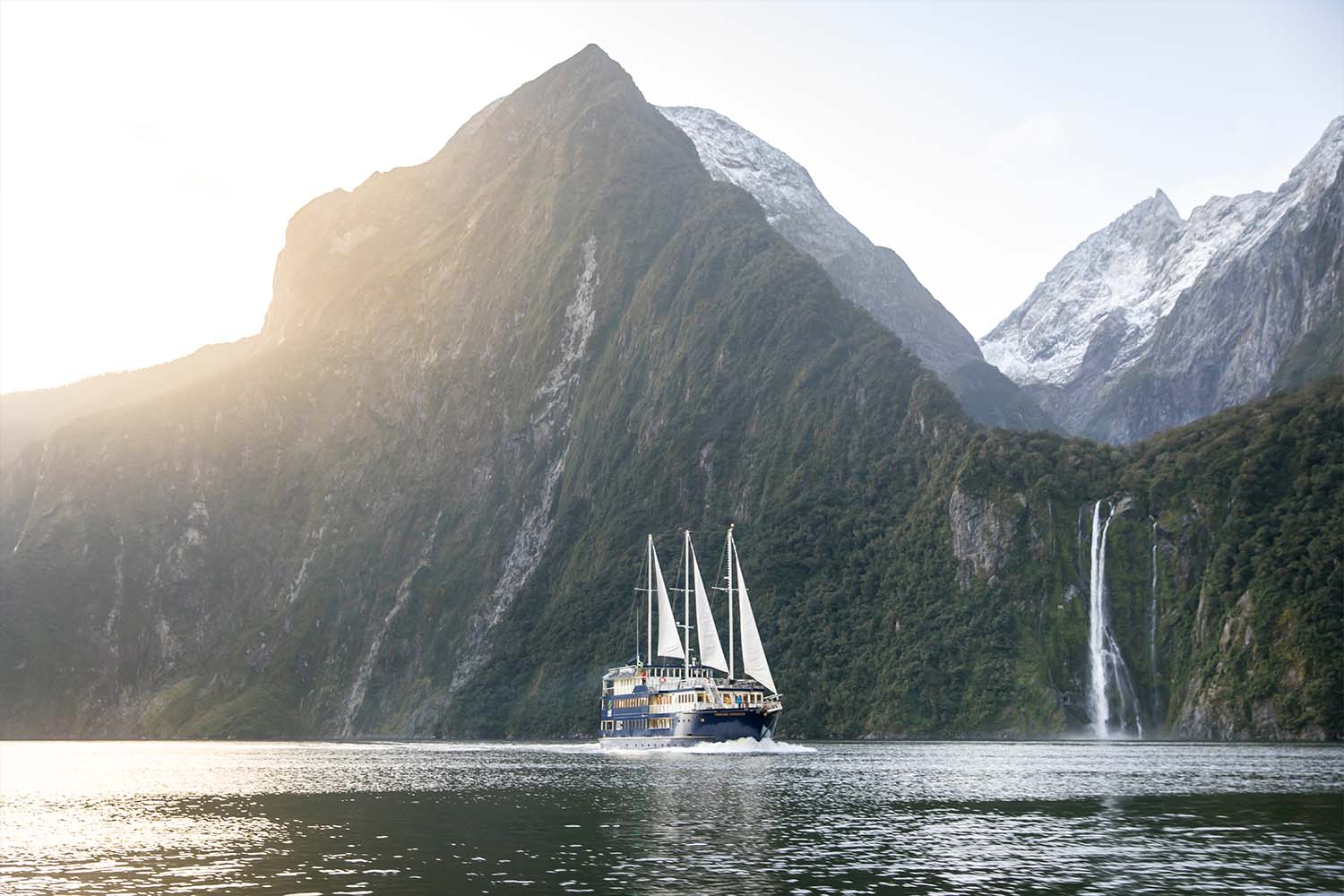

What to do in Queenstown:
Milford Sound flight and cruise
Truly one of the most infamous tourist attractions in the country — if not the world — opt to skip the lengthy bus ride and just fly right into the sound on a private plane. From there, a brief cruise around the fjord lets visitors really experience the heart of Milford, before getting back on the plane and heading home. The whole thing takes around four hours and costs about $600 NZ, well worth the chance to see all this natural beauty from the air and by sea.
Oxbow Adventure Co.
If you haven’t indulged in any skydiving, bungee jumping, or otherwise death-defying adventure activities as of yet, Oxbow is the place to get into the mix. With off-roading, jet sprint boats and clay bird (skeet) shooting, visitors can opt for one activity, a pair, or engage in all three. By the end of the day, you might’ve uncovered a hidden talent for marksmanship, or just screamed your head off during the breakneck boat ride. Either way, these activities are designed to offer accessible danger, a little less risky than skydiving, but with all the adrenaline packed in.
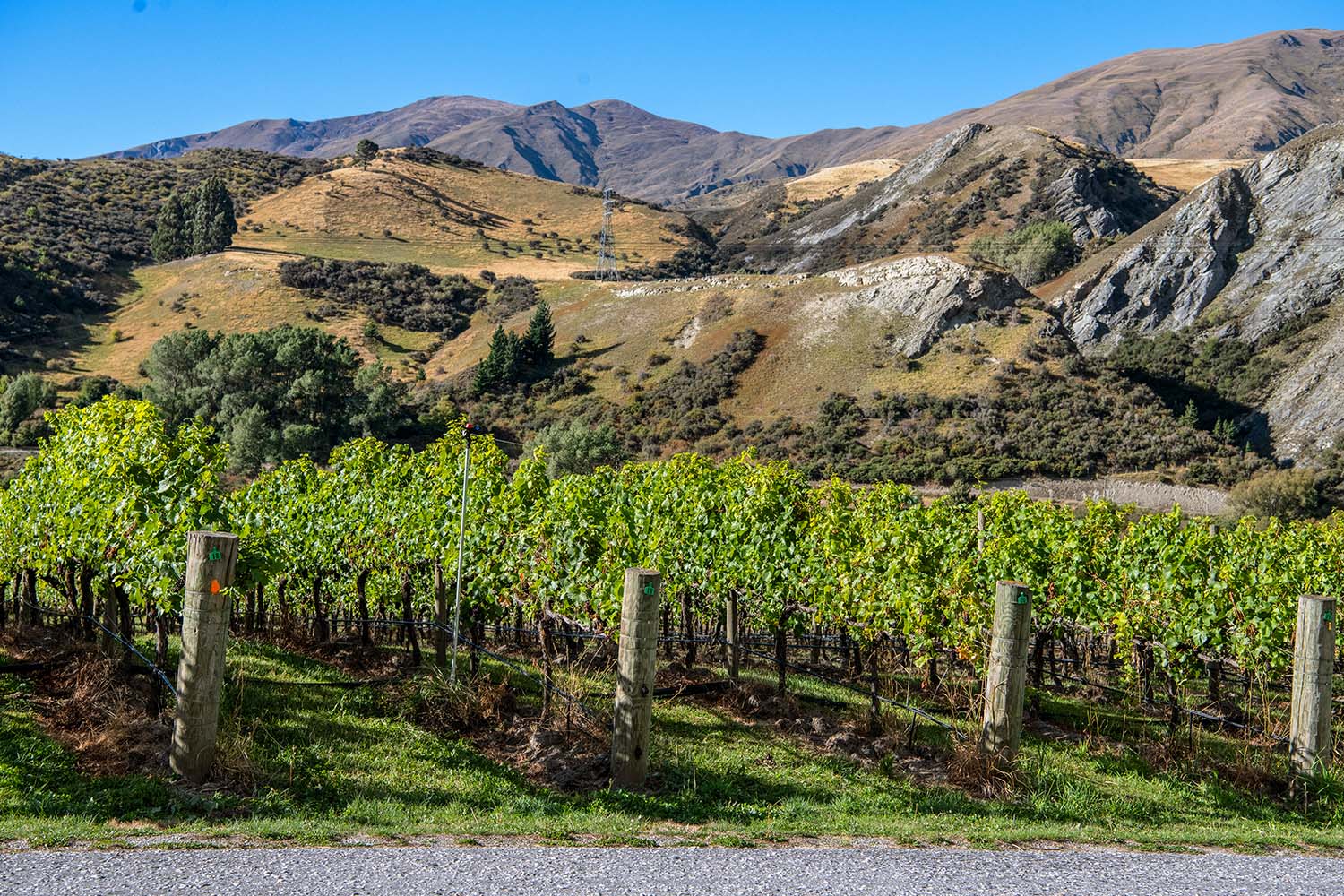
Gibbston Valley Cheesery & Deli
On the way out to Oxbow, or on the way back, pull into the Gibbston Valley Cheesery & Deli compound for a master class in hospitality at its finest. There’s wine cave tours, a tasting room experience, a cheesery, woodfired pizza hut, guest lodging and so much more. Whether you’re a cheese fanatic or studying for the next level of your WSET and ready to flex your wine tasting chops, there’s something here for all the foodies and winos.
Skyline Queenstown
Once again, it’s the journey that makes this tram ride a must, not the boilerplate restaurant at the top. Still, the Skyline comes much more highly recommended than the Wellington Cable Car, partially because the views are that killer and partially because it goes like a hundred times as high.

Where to eat in Queenstown:
Blue Kanu
The locals running the ship at Oxbow recommended Blue Kanu to me, and we couldn’t have been more grateful. It was a delicious mashup of pan-Asian cuisine, similar to what was going on at Koji, but with more of an emphasis on Kiwi and Fijian seafood and even some Polynesian influences. They call it a mix of Pacifica and Asia that becomes “Polynasia,” so make of that what you will.
Margo’s
As a Californian, I’m pretty picky about the authenticity of my Mexican cuisine, but even I had to give it up for Margo’s, a Mexican fusion spot with killer blended margaritas (virgin or otherwise) and a whole host of tacos that lean into pork belly, fried chicken, artichoke and more. Fish tacos make the most sense from a Kiwi point of view, and even their queso — which could hold its own against local LA options — leveled things up with toasted seeds and smoked corn salsa. A whole smattering of vegan options and a party atmosphere made this place officially the most versatile restaurant in town, so definitely make a reservation if you want to stop by, it gets crowded quickly.
Heading home
After dropping off my rental car, I took an Air New Zealand hopper flight from Queenstown to Auckland. I booked this flight about three months before the trip and it cost me $130 USD. It was just under a two hour flight, akin to an LA to Phoenix route. As I’m a huge proponent of airport hotels, particularly when it comes to international destinations I’m not all that familiar with, I flew back up to the north island the day before my flight home and booked into the Novotel Auckland. This turned out to be a great idea, as flash flooding in the airport a few days earlier meant things were still very chaotic.
Luckily, the Novotel was literally across the street from the international terminal, as in, less than a block away. I was able to sleep in, grab a leisurely breakfast and a shower, and still show up at the counter at 11:30 AM to check in for my 1:45 PM flight. The alternative to that was leaving Queenstown on a 7 or 8 AM domestic flight, schlepping to the international terminal, and going through security a second time in one morning to then board a 14-hour flight home. Airport hotels, they’re worth their weight in gold.
Thanks for reading InsideHook.
Sign up for our daily newsletter to get more stories just like this.
